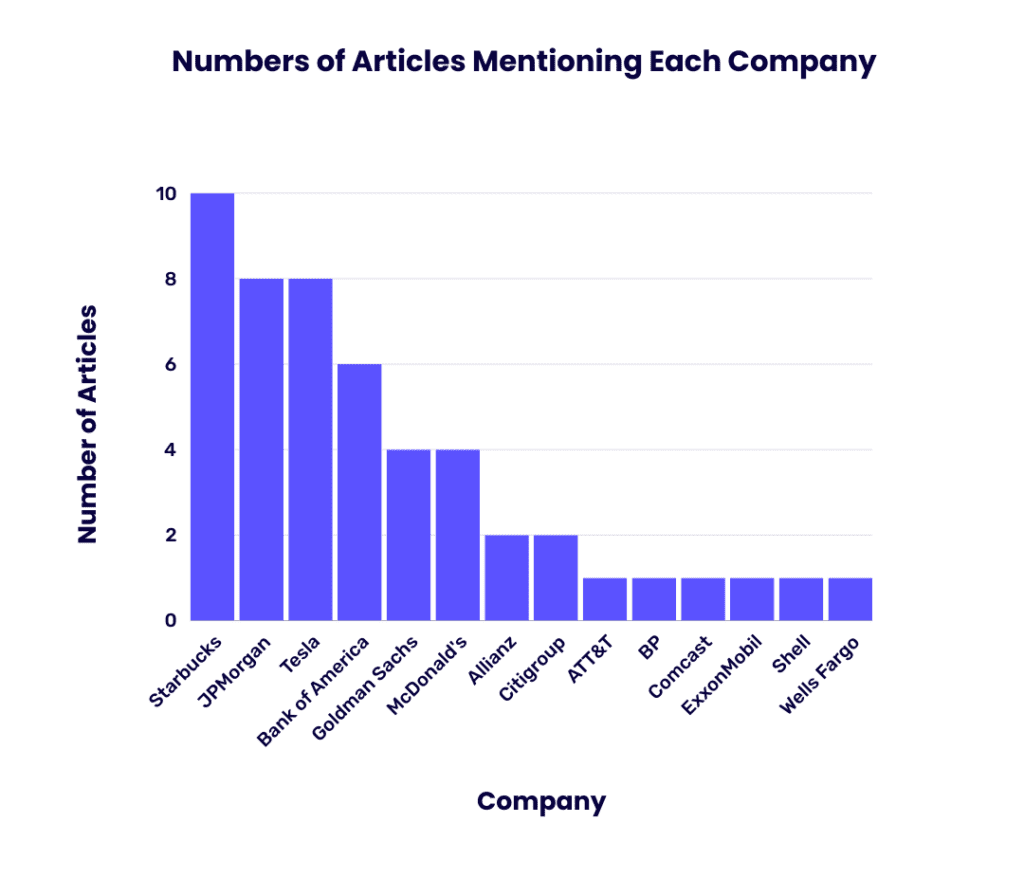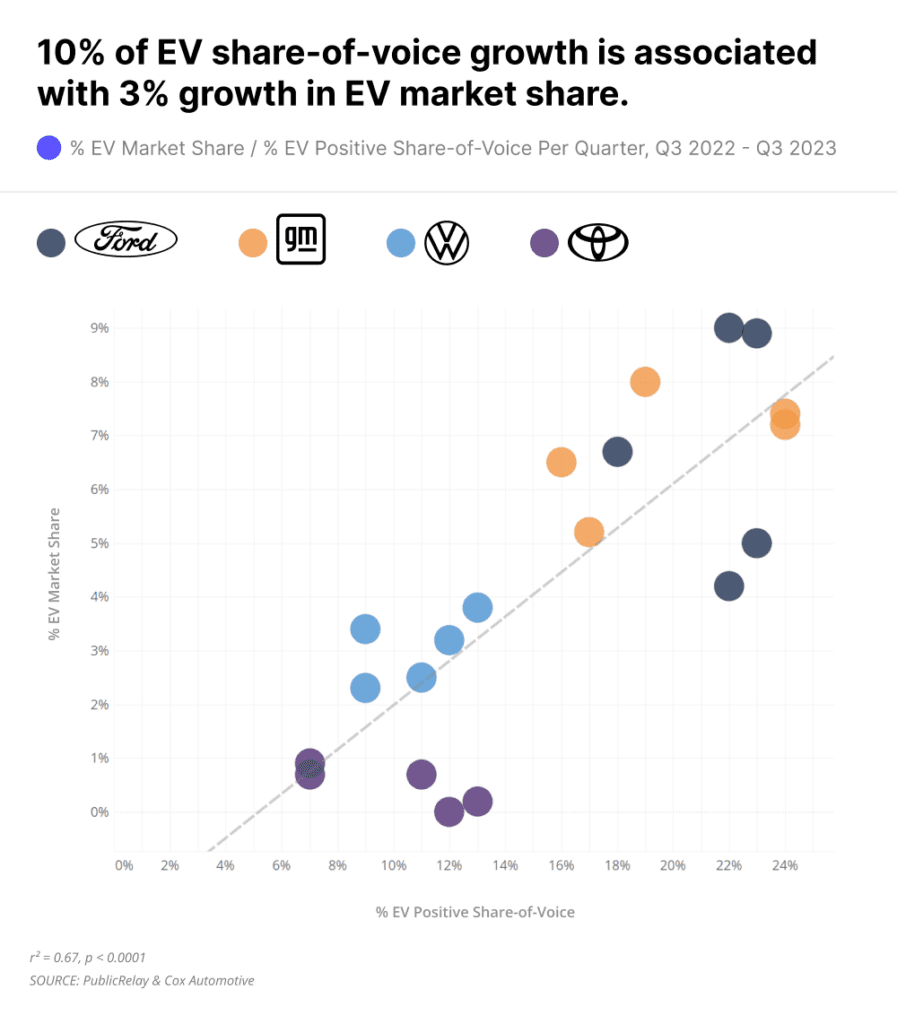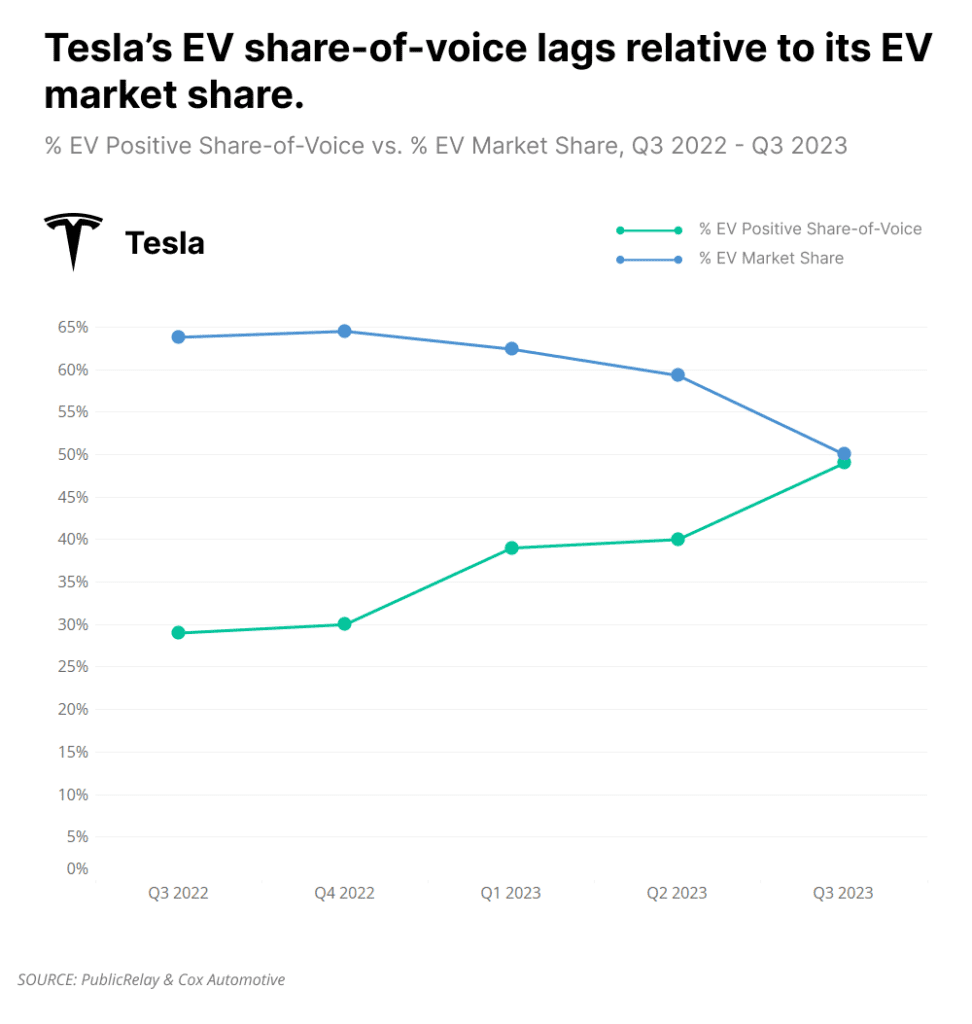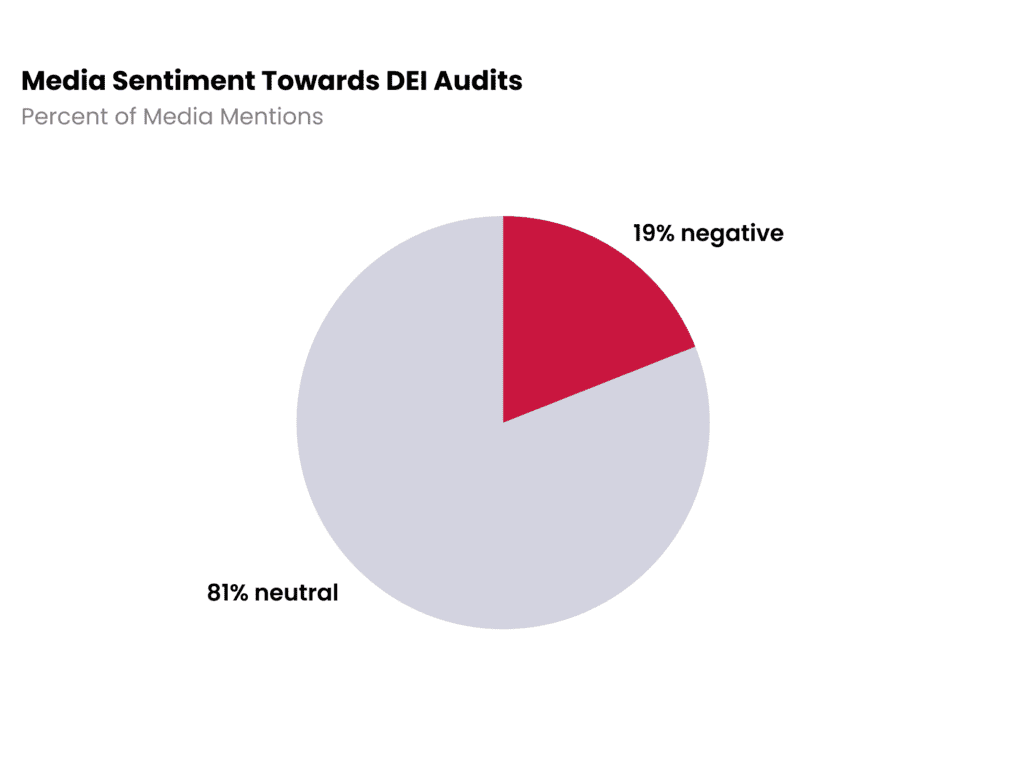
The Olympic Appeal: A Media Opportunity Like No Other
With the 2024 Paris Paralympics set to start soon and focus quickly shifting to the 2026 Winter Games in Milan and the 2028 Games in Los Angeles, many PR and Communications executives are preparing to capitalize on the opportunities the events provide for brands with Olympic media coverage.
The Olympics offer a golden stage for brands to showcase their message to a global audience. As one of the most-watched events globally, the Olympics had 30.6 million viewers in 2024. The sheer number of eyeballs glued to screens worldwide offers an unparalleled platform for brands to showcase their messages.
One company that seems to have benefited greatly in media coverage of their Olympic support was Comcast. Every mention we analyzed was either neutral or positive in tone. In fact, there were glowing accounts of Comcast’s Peacock app coverage, their use of shortform content on social media, and more.
For smaller brands as well, the Olympics can be a game-changing opportunity. A well-executed campaign can introduce a brand to millions, creating lasting impressions that can drive business growth.
However, this high visibility can also attract unwanted attention.
Our analysis of corporate media coverage around the Paris games surfaced some insights that could help communicators make the most of these upcoming opportunities and avoid the potential risks involved.

The Dark Side of Olympic Media Coverage
While the Olympics offer immense opportunities, they also come with significant risks. A lot of eyes can be great for a winning campaign – or it can go down in history as an utter failure. Further, controversies that extend beyond sports often surround the games.
The Consequences of a Misfired Campaign
Given the visibility of the Olympics, there are elevated stakes for high media uptake on a brand campaign. A campaign that missteps in tone can have an effect opposite the desired brand impact. This year, one of the more visible misfires was Google’s Gemini advertisement, which Google pulled from the Olympics airwaves after backlash in the media. While it seemed intent to represent a cute interaction between a child and her role model, it was accused of endorsing “automation instead of authenticity” over the use of AI to write a fan letter, something which many could argue goes against the Olympic spirit.
Another example of Olympic sponsorship backlash involves Toyota’s use of hydrogen-powered cars as official transport vehicles during the games. While the initiative intended to showcase Toyota’s commitment to sustainable technology, environmentalists criticized it, arguing that the vehicles were not as green as they appeared. Critics pointed out that hydrogen production often relies on non-renewable energy sources, making the cars less environmentally friendly than their all-electric counterparts. This criticism was covered in major outlets, and serves to highlight the complexities of promoting innovative green technology on a global stage. It also underscores the risk of backlash when a sponsor’s environmental claims do not fully align with public expectations.
We also see this misalignment with Olympics sponsor Coca-Cola. The company was hit with negative coverage on multiple fronts around their support of the Games. At an event deemed “one of the most eco-friendly Games in history”, Coca-Cola, came under fire from environmental groups and athletes alike for its use of plastic, warranting an official response from the company. Then, in another instance, health experts called Coca-Cola’s role as a sponsor in general into question. They claimed the organization was “sportswashing” its generally unhealthy products by aligning with the athletic endeavors of the Olympics.

The Decline of the Olympic Brand
Toyota again made headlines for its decision to end its sponsorship of the Olympics after Paris 2024. The company’s withdrawal from Olympic sponsorship highlights two significant reputational risks associated with sponsoring the games: geopolitics and athlete welfare.
Firstly, the geopolitical landscape surrounding the Olympics has become increasingly fraught. The games are often mired in scandals, corruption, and controversies over host nations’ human rights records. Toyota, like many global brands, found its reputation at risk by being linked to these issues. This was especially true during the Tokyo 2020 games, which faced heavy criticism for proceeding amid the Covid pandemic and local corruption scandals. Increasing geopolitical instability means Olympics sponsors are likely to face more reputational challenges related to these issues in the future.
Secondly, Toyota was concerned about how its sponsorship money was allocated, with reports indicating that funds were not effectively used to support athletes or promote sports. This misalignment with the company’s values led Toyota to conclude that the risks of continuing its sponsorship outweighed the potential benefits.
In Summary: The Complex Landscape of Olympic Branding
The Olympics present a unique media opportunity for corporate branding, but the landscape is fraught with challenges. The Olympics has two main types of PR risks:
- External risks in terms of the controversies the Olympics brand itself attracts, and –
- It is also likely to magnify preexisting reputational issues due to the heightened visibility.
While at face value the Olympics bring about an image of excellence, friendship, and respect – values any company would be proud to associate with – global realities and stakeholder expectations adds more to the picture that communications leaders should be aware of.
To learn more about our research and analysis, contact us here.
Related Resources


The alignment between a company’s public statements and its actions has never been more crucial. Reputation-reality gaps, i.e., inadequate actions to back up PR statements, are increasingly seen as hypocritical, damaging brand reputation, trust, and loyalty. An example that underscores this is the response to Mondelez following the invasion of Ukraine.
The company publicly announced intention to scale back operations in Russia, aligning with global sentiments against Russia and showcasing solidarity with the Ukrainian cause. However, despite its statements, the company continued to generate revenue and pay taxes in Russia. This discrepancy between its public commitments and ongoing business activities created a significant reputation-reality gap.
Consumers, especially in Europe, took notice. The perceived hypocrisy led to boycotts of Mondelez products across the continent. These boycotts weren’t just a fleeting reaction but a clear message from the public: companies must practice what they preach.
The situation with Mondelez (and Unilever, and Heineken, and more) serves as a stark reminder of the importance of consistency between words and actions. For brands, maintaining credibility requires more than just making the right statements.


The Importance of Alignment
In the age of information, consumers are more informed and empowered than ever before. They have access to a wealth of information at their fingertips and are increasingly holding companies accountable for their actions. Social media platforms amplify their voices, enabling them to share their opinions and mobilize others quickly.
For businesses, this means that the stakes are higher. Public statements are scrutinized, and any discrepancy between what a company says and what it does can quickly become a focal point for criticism.
When Mondelez announced its decision to scale back operations in Russia, they likely intended to align with global sentiments and show support for Ukraine. However, the continued revenue generation and tax payments in Russia told a different story. The gap between words and actions was seen as hypocritical, and the backlash was swift.


The Consequences of a Reputation-Reality Gap
The boycotts of Mondelez products in Europe highlight the tangible consequences of a reputation-reality gap. Boycotts can lead to a significant loss of revenue and market share. More importantly, they can damage the long-term relationship between a brand and its consumers.
When consumers feel that a company has been dishonest, their trust in that brand erodes. Trust is a fundamental component of brand loyalty. Once it’s broken, it’s incredibly challenging to rebuild. This is especially true in today’s competitive market, where consumers have numerous alternatives to choose from.
Moreover, the impact of a damaged reputation extends beyond just consumers. Investors, partners, and employees also take note of these discrepancies. A company that is perceived as hypocritical may struggle to attract and retain top talent. Investors may lose confidence in the company’s leadership and long-term strategy. Partners may reconsider their relationships, fearing that association with a discredited brand could harm their own reputation.
Lessons for Communicators and Business Leaders
The Mondelez case offers several important lessons for communicators and business leaders:
- Ensure Consistency Between Words and Actions: It’s not enough to make the right statements. Statements must align with actions, and communicators should inform other leaders within the organization of the importance of this consistency.
- Be Transparent: If there are challenges or limitations to what a company can do, it’s better to be upfront about them. Transparency builds trust and shows that the company is committed to being honest with its stakeholders.
- Monitor and Respond to Public Sentiment: It’s essential to stay attuned to public sentiment. Companies need to monitor media to understand how their actions and statements are being received. Prompt and appropriate responses can help mitigate potential backlash.
- Prepare for Crises: Despite the best efforts, crises can still occur. Companies need to have a robust crisis management plan in place to respond quickly and effectively. This includes having a clear communication strategy to address any gaps between words and actions.
Moving Forward
The case of Mondelez is a powerful reminder of the importance of aligning public statements with actions. In today’s interconnected world, consumers, investors, and other stakeholders are more vigilant and vocal than ever before. They expect companies to live up to their commitments.
For companies, this means that maintaining credibility requires a concerted effort to ensure that actions consistently align with words. It’s about being genuinely committed to the values and principles that the company espouses.
By doing so, companies can not only avoid the pitfalls of a reputation-reality gap but also build stronger relationships with their stakeholders. This in turn can lead to greater long-term success.
The high cost of a reputation-reality gap underscores the need for companies to act with integrity and consistency. The backlash faced by Mondelez and other companies serves as a cautionary tale for all businesses and a reminder that in today’s world, actions speak louder than words.
To learn more about ways you can measure and manage your reputation, contact us here.
Related Resources


In today’s interconnected world, geopolitical events often create ripple effects that reach far beyond their points of origin. For corporations, this interconnectedness means that events on the global stage can impact stakeholders, influence brand perception, and necessitate a response.
Navigating these waters requires careful consideration and strategic decision-making. For PR and Communications executives, the question becomes: when and how should we engage in corporate advocacy around a geopolitical issue?
This guide will help you determine the right course of action for your organization.
Download our supplemental worksheet, “Should I Speak Out?”
1. Identify Which Stakeholder(s) This Geopolitical Issue Affects
The first step in addressing a geopolitical event is to identify the stakeholders impacted by the issue. Stakeholders can include employees, customers, investors, partners, and more. Each group may be affected differently, so understanding these nuances is crucial. For example:
- Employees: Consider whether your employees are from or have ties to the region affected by the event. Their safety, well-being, and morale might be at stake.
- Customers: Evaluate if your customer base includes individuals or businesses in the affected region. Consider their potential concerns and sentiments.
- Investors: Assess whether investors are likely to be impacted financially or have ethical concerns about the geopolitical event.
- Partners: Determine if your business partners operate in or are connected to the affected area, influencing supply chains or collaborative ventures.
2. Determine Which Values the Stakeholder Holds Regarding the Geopolitical Issue
Understanding the values and desired outcomes of your stakeholders is essential. This step involves gauging their perspectives and expectations regarding the geopolitical event.
Questions to Consider include:
- Do stakeholder preferences vary by region? For instance, a geopolitical issue might be viewed differently in Europe compared to Asia.
- Does the stakeholder’s values or outcomes overlap with a social or political stance? This could include issues such as human rights, environmental concerns, or economic impacts.
- Has this stakeholder voiced concerns already? This can be through direct communication, social media, or public statements. Listening to these voices can provide valuable insights into their priorities and expectations.
3. Answer Yes or No: Does our organization share any common values with the stakeholder, and does our organization support the stakeholder’s preferred outcomes?
After identifying stakeholder values, the next step is to evaluate your organization’s alignment with these values and outcomes.
- Common Values: Analyze whether your organization’s core values resonate with those of your stakeholders. Shared values form the foundation for credible and authentic advocacy.
- Support for Outcomes: Determine if your organization supports the preferred outcomes of the stakeholder. This alignment is crucial for building trust and ensuring that any corporate advocacy efforts are seen as genuine and not merely performative.
4. Answer Yes or No: Does our organization have a track record of specific actions that are consistent with its shared values with the stakeholder?
Consistency between words and actions is vital for credible corporate advocacy.
- Internal Actions: Review your organization’s internal policies, initiatives, and culture. Have you historically taken actions that align with the values and outcomes of the affected stakeholders?
- External Actions: Consider your organization’s external engagements, such as partnerships, community involvement, and public statements. A track record of external actions that support shared values enhances credibility and demonstrates a genuine commitment.
These are important to understand and align with, because failure to do so can lead to negative media coverage. For example, Meta, has been called out for overreaching with oversized censorship of content related to Palestine, which is out of line with their community guidelines.
5. Answer Yes or No: Does our organization have specific actions it can or will take?
Are those actions:
- Impactful to the Geopolitical Issue: Assess whether your organization can take actions that meaningfully impact the geopolitical issue. This could involve financial contributions, advocacy, or operational changes.
- Consistent with Shared Values: Ensure that these actions are consistent with the shared values between your organization and the stakeholders.
- Able to Satisfy Stakeholder Outcomes: This involves understanding their expectations and aligning your actions accordingly.
For example, mere days after the Russian invasion of Ukraine, Shell announced its exit from approximately $3 Billion worth of stakes in Russian-situated assets, while Netflix suspended service in Russia. Both actions cost the corporations money, but were viewed positively by stakeholders who were against Russia’s actions.
Evaluating the Decision
For steps 3 through 5, if you answered YES to all, your organization has a story to tell that is impactful to the geopolitical conflict and your affected stakeholder. You should engage in corporate advocacy.
If you answered NO to 1 or 2 questions: Assess the areas where your organization is falling short or disagrees with the affected stakeholder. Those are areas of potential risk to engaging in corporate advocacy that communicators should prepare for.
If you answered NO to ALL: It’s likely best that you don’t speak out. The risk of backlash from the stakeholder is greater than the reward.
Assessing Broader Implications
After completing steps 3 through 5 for each stakeholder group, ask yourself whether engaging in geopolitical advocacy will alienate or threaten your standing among other stakeholders. This is to ensure your stakeholders are aligned. This is relatively straightforward – if the answer is YES, it will alienate other stakeholders, then there’s high risk of backlash that you should prepare for. If the answer is NO, and your stakeholders are aligned, you should have a low chance of negative reactions and can feel comfortable speaking out.
Other Questions to Consider When it Comes to Corporate Advocacy:
- Is this the first time you are speaking out? Consider the precedent you are setting. If this is the first time your organization is engaging in corporate advocacy, ensure that you have a robust strategy and clear communication plan.
- Will speaking out now land with your stakeholders? Are you too late to the conversation? Timing is critical. Engage early to avoid being perceived as reactive rather than proactive.
- Are you backing up your advocacy with specific actions? Advocacy without actions creates a risk of backlash. Where possible, ensure that your statements are supported by concrete actions to avoid being seen as insincere or opportunistic.
Planning Your Response
Prepare to communicate your shared values and your track record of actions to address concerns brought by disaffected stakeholders. This involves crafting clear, transparent, and empathetic messages that acknowledge their perspectives and outline your commitment to addressing the issues. At certain times, company values might dictate a response regardless of the outcomes of the above process, so your best course of action will be to prepare. Consider how you’ll respond to reactions, whatever they may be.
Conclusion
Engaging in corporate advocacy around geopolitical events is a complex and nuanced decision. By following this structured approach, PR and Communications executives can make informed choices that align with stakeholder values, support meaningful outcomes, and enhance organizational reputation. Remember, the key is to ensure that your advocacy is authentic, backed by action, and considerate of the diverse perspectives within your stakeholder community. Be prepared for potentially negative responses if your company values are at odds with what certain stakeholders may be looking for.
As you navigate this process, stay attuned to the evolving geopolitical landscape and be prepared to adapt your strategies. Effective corporate advocacy not only addresses immediate concerns but also builds long-term trust and credibility with your stakeholders.
To learn more about the research that supported the creation of this blog, contact us here.
Related Resources


Held July 25-26 and hosted by PRSA Orlando in partnership with PRSA Sunshine District, SunCon 2024 brought together some of the brightest minds in communications and PR to discuss the importance of strategic storytelling in developing and implementing effective public relations campaigns and beyond.
Here are the key takeaways from this year’s event:
1. The Line Between Internal and External Communications is Closing
What is Sent Internally Now Shows Up on External Platforms
The boundary between internal and external communications is increasingly blurred. Information shared within a company often finds its way onto public platforms, making transparency and consistency essential.
Employees are Advocates for Your Brand
Employees are not just staff; they are ambassadors for your brand. Their voices and actions can significantly influence public perception. Encouraging and equipping employees to positively represent the company is more crucial than ever.
Companies Need a Modern-Day Employee Communications Plan
To keep pace with the changing dynamics, companies must develop robust internal communications strategies that align seamlessly with their external communications. This includes leveraging modern tools and platforms to engage employees effectively and ensure they are well-informed and motivated advocates.
2. Print and Broadcast are Still Leading Pillars of the Comms & PR Industry
Broadcast and Print Used to Be the Only Key Players
Historically, print and broadcast media dominated the communications landscape. These traditional mediums were the primary channels for reaching large audiences and shaping public opinion.
Digital and Social Have Cemented Their Place at the Table
The rise of digital and social media has transformed the industry, providing new avenues for engagement and content dissemination. These platforms offer immediacy and interactivity, enabling brands to connect with audiences in real-time.
Big Print and Broadcast Still Set the Pace
Despite the growth of digital and social media, traditional print and broadcast outlets often set the agenda. Stories that gain traction in these mediums frequently become viral topics on social platforms, underscoring their enduring influence.
3. Data Drives Everything
Businesses Need to be Numbers-Driven to Succeed
In the modern business environment, data is king. Companies that harness data to inform their strategies and decisions are better positioned to succeed.
Quality Data is Required for Quality Insights
Accurate and comprehensive data is the foundation for meaningful insights. Investing in high-quality data collection and analysis is essential for making informed decisions and identifying opportunities.
Look at Trends and Microtrends to Identify Opportunities and Risks
Staying ahead requires monitoring both macro trends and microtrends. Understanding the nuances of these trends can help businesses anticipate shifts in the market and respond proactively.
Example: Stanley Drinking Cups
Stanley, traditionally a blue-collar brand, experienced a dramatic shift when their drinking cups became a viral sensation on TikTok. This led to a surge in sales from 75,000 to 750,000 units annually. By analyzing big data, Stanley was able to quickly forecast and plan for this drastic increase in demand, showcasing the power of data-driven decision-making.
4. Embracing Change is Critical to Your Career
Change is Happening at a Quicker Pace
The communications and PR industry is evolving rapidly. From the advent of social media to the rise of analytics and now AI, change is constant and accelerating.
Have a 3-Year Plan and Upskill Yourself
To thrive in this dynamic environment, professionals need to be proactive. Developing a three-year plan and continuously upskilling is essential. Staying ahead of the curve requires adaptability and a commitment to lifelong learning.
Related Resources


The recent CrowdStrike outage has generated significant media coverage. We examined how various sectors and companies were mentioned to gain insight into the media’s priorities and their brand impact.
In short – and rather unexpectedly – the event had minimal negative impact on most companies’ media coverage, while for some, coverage was actually brand-positive.
Essential Services and Media Focus
We analyzed coverage of the CrowdStrike story across all the sectors in our Benchmark dataset, which tracks 49 global organizations across 9 industries, and found surprisingly low volumes across all of our non-Tech sectors.
However, our data shows the Finance sector was mentioned most out of our tracked industries, following a broader pattern where coverage gravitated toward sectors where disruption was most palpable to the public, such as everyday banking services.


Most coverage about the CrowdStrike outage focused on disruptions to time-sensitive essential public services like transport, healthcare and emergency services. A prominent example in transportation is Delta, who even 5 days after the incident is still having to cancel flights due to the issue, generating sustained media coverage as a result. Nonessential businesses, on the other hand, were generally spared scrutiny.
Starbucks: The Unexpected Essential Service
A deeper dive into the data by company surfaced Starbucks as the most mentioned brand, with 10 articles covering the impact of the outage on its services. This is striking given that Starbucks is a coffee retailer, not typically associated with critical infrastructure or essential services. The high media attention highlights an interesting perspective: Starbucks has become a significant part of many people’s daily lives, to the extent that disruptions to its service are considered noteworthy.


The media focus and portrayal of Starbucks as an essential service highlights how deeply the brand is embedded in daily life. Articles often included quotes from social media users that suggested that, for many, a day without their Starbucks coffee is a significant inconvenience, akin to disruptions in banking or transportation. In fact, in some instances, Starbucks closures were mentioned in the very same headline as these more essential services.
Mentions such as these were largely lighthearted in nature, with social media commentary from customers more so lamenting that their typical coffee routine was disrupted rather than placing any sort of blame on Starbucks itself. This spotlight on Starbucks generated a narrative that the brand is crucial for daily functioning, a testament to its strong market presence. For Starbucks, therefore, the CrowdStrike outage turned out to be brand-positive.
Preparing for the Next Outage
Communicators can expect that if a similarly widespread outage occurs in the future, it is unlikely to affect the majority of brands’ media reputation. Disruptions to time-sensitive essential services will draw most of the negative media attention, while businesses offering non-essential or non-time-sensitive products and services can fly under the radar.
For some lucky companies, a short disruption to services could even remind the public how beloved and essential their brand has become. This phenomenon underscores the importance of building a strong brand presence and fostering deep customer connections which can act as a buffer during crises such as this one.
To learn more about our research, contact us here.
Related Resources


As the Israel-Hamas war has unfolded, stakeholders are re-evaluating companies based on their ties to the conflict.
PublicRelay examined how public opinion and media reporting on major brands has evolved since the start of the conflict. We found that ties to the Israeli government are a looming corporate reputational risk. And that threat is set to grow as Americans become increasingly sympathetic to the humanitarian crisis in Gaza.
There’s been a remarkable shift in public opinion in the last six months


Polling data from Gallup reveals that early opinion towards Israel’s military strategy was in the country’s favor. At this point, Israel was still reeling from Hamas’ October 7th attacks.
The Israeli government’s reaction was at the center of news coverage in November. The media commended corporate leaders for backing Israeli citizens in need. This included Google’s Sundar Pichai and JPMorgan’s Jamie Dimon, who expressed steadfast support for the country.


But as time marched on, Americans became more aware about the humanitarian crisis in Gaza. By March, public opinion had largely turned against the Israeli military strategy. Media reporting reflected this, as coverage of Palestine and Gaza overtook mentions of military conflict between Israel military and Hamas for the first time.
As the attention on Gaza has grown, so has the backlash on brands’ ties to the Israeli military. The mainstream media that once praised businesses for showing support now spotlight accusations of bias against Palestine.
Exposure to the conflict is both an external and internal communications issue
We found that some of the largest companies in the world have been unprepared to respond to consumer backlash. Both McDonalds and Coca-Cola have already reported declining sales linked directly to boycotts. This is especially a risk for companies with younger audiences, who have been the driving force behind protests.
But the consequences go beyond your customer base. Protests by activist employees have steered the media cycle in recent months. This creates an internal communications issue that could put all companies with ties to the Israeli government at risk.
Google, for example, has been traditionally known for their open work culture. In recent months, the company faced internal backlash over their Israeli military contracts. The tech giant has limited company message boards and fired protesters, acting out-of-line with their cultivated brand image. High profile outlets have called out Google’s ambiguous public statements on their actions. Their response has fueled a narrative of unpreparedness around internal dissent.
Plan your response today
As American opinion continues to turn against Israel’s military actions, it’s clear that organizations with ties to Israel’s military have unavoidable exposure to the public discourse. Smart leaders should assess their risk profile relative to their customer and employee bases and plan responses now. Communicators need to prepare targeted response strategies ahead of time to effectively address concerns from external and internal stakeholders alike.
To learn more about our research contact us here.
Related Resources


Key Takeaways
- The best PR responses to a crisis occur within 24- to 48-hours after the initial media firestorm.
- Product issues can generate the worst PR crises in the short-term. A failing product can generate 135x more negative coverage for a brand than during an average day.
- Data breaches and governance crises have the biggest long-term impact on reputation. Companies with those crises had the most negative media sentiment six months later.
- Social and political crises have relatively minor long term impacts. Stakeholders may ultimately judge companies on their commitment to core business goals over their social and political values.
PR crises can swiftly impact a company’s reputation and bottom line. Some crises can shed up to half of a company’s stock price for over 2 years.
Yet few companies are adequately equipped to respond to a crisis. It’s vital for PR teams to build concrete plans ahead of time, so what should they consider when building crisis communications plans?
A good crisis response first requires understanding the types of crises and how they unfold. While crises have similarities, they’re not all created equal. The media treats news around a product failure differently than a DE&I controversy, for example. Communicators need to be ready to respond to different crises differently.
What is a PR Crisis?
A PR crisis is an event that harms an organization’s reputation, credibility, or operations. In these moments, negative media coverage reaches new highs. PR teams often drop everything to focus on the problem.
PublicRelay reviewed 100+ crises across nearly 40 companies spanning over 10 industries. Pulling this data together gives insight into how a crisis could play out during the initial shock period of media reporting.


These crisis shocks have little warning. On average, crisis chatter grows rapidly in just a day to reach peak negativity, or when the media firestorm reaches its highest point.
On one hand, crisis shocks are generally short-lived. Negative coverage usually returns to pre-crisis levels in little over a week following a rapid decline within the first two days.
On the other hand, there is very little time to respond. The news cycle may move on after a few days, but public opinion cements quickly and can generate lasting reputational damage.
We found that the best PR responses occur within 24 to 48 hours after peak negativity. This window is when counter-messaging is most effective and communicators can mitigate the long-term reputational damage caused by the crisis.
What are the different types of crises?
Understanding how crises are different can also help predict how bad they will be. We grouped crises into three broad categories:


- Governance Crises: Triggered by lawsuits and regulatory investigations, these occur most often in the corporate landscape. Examples include misleading product claims, blocked mergers, and product safety lawsuits. They call into question a brand’s corporate integrity and compliance.
- Consumer Impact Crises: Issues like product failures, safety concerns, and price hikes fuel this type of crisis. They drive a customer’s experience with a brand. As a result, they generate headlines in mainstream media. Common examples include prolonged service outages and product recalls.
- Environmental and Social Crises: These crises are tied to a company’s socio-political standing. Examples include backlash over diversity issues and ecological damage. Crises like these often drive social media buzz and potential boycotts.
In the short-term: How bad is bad?
In the moment, some crises can be worse than others. To compare how bad crises are as they’re happening, we analyzed their peak negativity. We examined how bad the most negative day of a brand crisis was by comparing it to the brand’s negativity during an average day.
Crises like Product Failures and Safety lead to the most negativity. A failing product can generate 135x more negative coverage for a brand than during an average day. Product stories impact everyday news readers, so they quickly catch the attention of mainstream outlets.


In contrast, issues like Executive Behavior and Environmental Misconduct only receive 20-30x more negative coverage than during a brand’s average day. Those crises are serious, but they may generate less news. Their impact on the public may be hazy and the media pickup can be limited to niche trade publications.
In the long-term: How will it affect my reputation?
Once the initial shock dissipates, the PR work isn’t over. Even when the media cycle moves on, the effects of a crisis can linger for months or years.
To understand the long-term effects of crises on brand reputation, we compared the average media tone of each brand six months before and after a crisis.
The results showed that some crises are easier to recover from others. Data Breaches stand out for their enduring negative impact on reputation. Companies with data breaches had the most negative media sentiment six months later. Leaks from hacks can generate panic and concern among key stakeholders. Data breaches also attract lawsuits and regulatory responses which draw out their lifespan.


Similarly, governance crises that erode shareholder trust can have lasting repercussions on a company’s reputation. Executive Misconduct, for example, had a persisting negative impact. This was despite those crises seeing less coverage when they first occurred.
Notably, social and political crises are easier to recover from. Backlash to a company’s Political Stances or Diversity & Inclusion initiatives did not often generate long-term negative reputational impacts. Stakeholders may ultimately judge companies on their commitment to core business goals over their social and political values.
Understand the crisis to plan your response
Becoming familiar with the different types of PR crises is critical. Not every crisis is the same, and they each have different short-term or long-term effects.
Consider the types of PR crises that can affect your brand and examine their characteristics. Doing so can help you plan your response strategy and resourcing needs for each different type of PR crisis.
To learn more about our research on PR crises, contact us here.
Related Resources


Key Takeaways
- For a tailored outreach strategy, communicators working with female CEOs should target highly syndicated outlets to help close the media visibility gender gap.
- Measurement approaches should take gender into account and consider female CEOs’ reputation impact, not just their media volumes.
In our analysis of CEO media representation, we found a significant gender disparity. While female CEOs lead 16% of companies in PublicRelay’s Benchmark dataset, they receive disproportionately less media attention compared to their male counterparts. Females account for only 5% of CEO mentions and quotes in news articles.


Social Media Amplifies Gender Disparity
This gender bias extends to social media users, where articles featuring female CEOs receive far fewer shares than those featuring male CEOs. On average, articles mentioning female CEOs are shared 42% less often than articles mentioning male CEOs. Similarly, on average, articles quoting female CEOs are shared 60% less often than articles quoting male CEOs.


Syndication Can Help Close the Gap
Syndication data is slightly less bleak. Female CEOs account for 5% of syndicated CEO mentions and 7% of syndicated articles featuring CEO quotes. In addition, the average syndication count for female CEO mentions and quotes is slightly higher than for their male counterparts.


Female CEOs Win on Sentiment
There is also a silver lining for female CEOs in media sentiment. Articles and quotes featuring female CEOs tend to have a more positive tone compared to those featuring male CEOs. This indicates a more favorable portrayal of female CEOs in the media.


Female CEOs Positively Impact Company Reputation
While male CEOs may have a slightly more positive personal brand, as measured by the ‘Perception Score’ element of PublicRelay’s CEO Index, female CEOs significantly outshine them in their impact on company reputation.
On average, female CEOs have a positive impact on their company’s reputation, with an ‘Impact Score’ of 2.2, whereas male CEOs’ impact on the brands they represent is actually negative on average, with a score of -0.74.


Diversity is Opportunity
The data highlights the persistent gender gap in CEO media representation and visibility. However, the positive media sentiment and impactful reputation of female CEOs compared to male CEOs underscore how important it is for brands to elevate diverse voices in corporate leadership.
Related Resources


Does Share of Voice = Share of Market?
The electric vehicle (EV) race is speeding along, fueled by automakers jockeying for consumers’ minds and wallets. As legacy car companies build their EV reputation, are their news headlines driving EV sales?
To answer this question, PublicRelay compared over a year’s worth of EV media coverage and sales from leading automakers. Here’s what we found:
Legacy car companies are ahead in consumers’ minds
Despite their late entrance to the EV race, legacy car companies have been punching above their weight on EV communications. Over the past year, legacy automakers’ positive share-of-voice on EVs has outpaced their EV market share.
That’s a communications win for legacy car companies, especially for GM and Ford. Those two automakers have branded themselves as leading EV players. GM CEO Mary Barra has vowed to close the EV sales gap with Tesla in 2025 and pledged to end sales of gas-powered cars by 2035. Ford CEO Jim Farley has publicly committed over $50 billion in EV investments alongside partnerships with Chinese and Korean battery firms.


The automakers’ PR strategies are borne out in PublicRelay’s analysis of the EV media landscape, featuring brands like Tesla, GM, Ford, Toyota, and Volkswagen. GM and Ford each maintain around 20% of the industry’s EV’s share-of-voice despite each having approximately 7% of the US’s EV market share. Even Volkswagen and Toyota have share-of-voices that exceed their shares of the market.
EV media wins are leading to market share gains
An outsized share-of-voice likely indicates future market share growth in EVs. Advertising firms like Nielsen have long highlighted the value of investing in media share-of-voice early to generate business growth later. That’s especially true when budgets are tight. Companies who build reputational strength early reap the rewards faster when market conditions mature.


That trend is already holding true for legacy automakers in the EV space. 10% more positive EV share-of-voice is generally associated with 3% growth in EV market share, quarter over quarter.
Tesla is losing market share, but its media share-of-voice is rebounding
Tesla’s trajectory is also consistent with this trend. Elon Musk’s company is the clear EV market leader. But unlike legacy automakers, Tesla’s PR efforts have significantly lagged its market power. At the end of 2022, Tesla’s share-of-voice was less than half its market share.
Combined with growing competition in the EV space, Tesla’s reputation deficit has predictably led to a decrease in its market share. Tesla’s share of the EV market has decreased from 64% to 50% in the past year.
Numerous controversies surrounding Elon Musk’s takeover of Twitter have alienated potential Tesla customers. Tesla also faces ongoing product reliability issues. Without sufficient reputational capital in place, EV buyers may be more willing to look beyond Tesla towards other brands.


Tesla is far from doomed, however. The company has been rapidly increasing its EV share-of-voice in 2023. Its market leader status has enabled it to capture headlines about lowering prices and the launch of the Cybertruck. The brand has been quick to point out its insulation from chip supply constraints and UAW strikes affecting Ford and GM.
The road ahead
At the same time, legacy automakers have begun to pull back from their bold EV stances amid high interest rates, fears about inadequate EV charging infrastructure, and a surge in hybrid vehicle sales. The result has been a decline in share-of-voice among legacy car companies at the end of 2023.
Whether or not legacy automakers renew their focus on their EV businesses through 2024 remains to be seen. If they do, building their EV share-of-voice will be a necessary place to start.
Read Next: Improve Your ESG Communications Strategy
Related Resources


As companies and shareholders increasingly prioritize diversity and inclusion efforts, many are turning to diversity audits to evaluate their progress.
However, our recent research suggests that these audits may not have the positive media impact that communicators might hope for.


Independent reviews of diversity and inclusion efforts have led to zero media reputation gains for the companies we track in our media Benchmark. In fact, controversy and skepticism surrounding the process of conducting such audits has meant coverage is neutral at best, and sometimes even negative.
The main contributor to negative sentiment was coverage of how the decision to conduct an audit was reached. Voluntary diversity audits were often framed as a reluctant reaction to pressure from shareholders, with plenty of commentary around companies’ initial pushback to the idea. Also, coverage often mentioned existing allegations of discrimination to explain shareholder demands for audits. This context undercut the potential reputational gains for diversity audit stories.
Another reason for the lukewarm coverage is that the auditing process is vulnerable to being portrayed as performative or insufficient. For example, the qualifications or independence of external auditors were often questioned in media coverage. Alternatively, if a company conducted an internal audit, media coverage suggested that the audit was biased or lacking in transparency. Issues related to the sufficiency, independence and transparency of audits together accounted for 24% of negative messages.


The recent politicization of corporate DEI initiatives also plays a role. The media will publish the ‘anti-woke’ rhetoric of shareholders who take issue with companies choosing to perform a diversity audit. This results in unwanted controversy – whether the articles in question are written in support of such views or not.
When diversity audits materialize, communicators should be prepared for the media to broadcast shareholder views. Whether these shareholders are for or against diversity audits, their comments are likely to be critical of the company, undermining any potential reputational gains.
In theory, showcasing the progress of diversity audits should be a great PR tool to demonstrate action and commitment to an important issue. However, in practice, results are neutral at best. While the media continues to frame these stories from the viewpoint of critical shareholders, communicators should minimize proactive messaging about audits, and look elsewhere for stories that can more effectively communicate their brands’ DEI values.











